|
|
|
Sort Order |
|
|
|
Items / Page
|
|
|
|
|
|
|
| Srl | Item |
| 1 |
ID:
136064
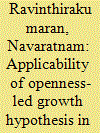

|
|
|
|
|
| Summary/Abstract |
An openness-led growth hypothesis investigates the causal relationship between trade openness1 and economic growth. Indeed, trade openness can stimulate economic growth by enhancing the international flow of knowledge and innovation and by allowing economies of specialization, not only in the production of goods, but also in the generation of new knowledge and new inputs into production. The purpose of this article is to empirically examine an openness-led growth hypothesis, using the case of Sri Lanka for the period from 1965 to 2012. The article uses the recently developed autoregressive distributed lag (ARDL) bounds test for cointegration developed by Pesaran et al. (2001). The empirical results confirm the validity of the openness-led growth hypothesis for Sri Lanka.
|
|
|
|
|
|
|
|
|
|
|
|
|
|
|
|
| 2 |
ID:
132644


|
|
|
|
|
| Publication |
2014.
|
| Summary/Abstract |
This paper explores the causal relationship between economic growth, trade openness and energy consumption using data of 15 Asian countries. The study covers the period of 1980-2011. We have applied panel cointegration and causality approaches to examine the long-run and causal relationship between variables.
Empirical results confirm the presence of cointegration between variables. The impact of economic growth and trade openness on energy consumption is found to be positive. The panel Granger causality analysis reveals the bidirectional causality between economic growth and energy consumption, trade openness and energy consumption.
|
|
|
|
|
|
|
|
|
|
|
|
|
|
|
|
| 3 |
ID:
161485
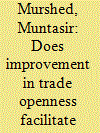

|
|
|
|
|
| Summary/Abstract |
The aim of this article is to empirically shed light on the impacts of trade openness (TO) on facilitation of renewable energy transition (RET) across Bangladesh, India, Pakistan, Sri Lanka and Nepal. Against this backdrop, this article incorporated annual time series data stemming from 2000 to 2017 and employed the two-stage least squares (2SLS) panel data estimation methodology. In addition, the panel Granger causality test was also applied to distinguish the possible long-run causal associations between the variables considered in the regression models. In the light of the estimated results, it is found that an improvement in TO triggers renewable energy consumption, improves the primary energy-use efficiency and elevates the access to clean cooking fuel technology within the selected South Asian economies. However, the results also led to the concerning conclusion regarding the ineffectiveness of the trade liberalization policies in curbing the relative consumption of non-renewable energy resources, thereby marginalizing the prospects of overall RET within these economies.
|
|
|
|
|
|
|
|
|
|
|
|
|
|
|
|
| 4 |
ID:
086406
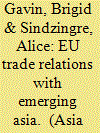

|
|
|
|
|
| Publication |
2009.
|
| Summary/Abstract |
Trade interdependence between Europe and Asia has rapidly increased in recent years. Europe-Asia trade flows now constitute a 'third link' in the global economy. As trade expands, however, global trade governance has declined and free trade agreements (FTAs) have increased. Hence, the Global Europe strategy has been designed to enhance trade relations with emerging Asia which is the most dynamic region in the global economy today. But Asia's model of export led growth leaves it more exposed to shocks emanating from outside the region than ever before raising questions about its sustainability. Deep integration agreements between Europe and Asia are needed to foster economic growth. They also need a development dimension to help Asian countries address their key development challenges.
Brigid Gavin was the Research Coordinator of the workshop on 'Deep Integration and North-South Free Trade Agreements: EU Strategy for a Global Economy' which provided the papers and discussion forum for the articles in this special edition. The workshop took place at the United Nations University-Comparative Regional Integration Studies (UNU-CRIS) centre in Bruges, Belgium on 19-20 June, 2008. She wishes to express her thanks to Mr Luk Van Langenhove, Director of UNU-CRIS for financial support and to all the authors and participants in the workshop for their contribution to making this project a real success. A special word of thanks goes to Lars Nilsson, Chief Economist Unit, DG Trade, European Commission for his opening presentation to the workshop.
Alice Sindzingre is Research Fellow, National Centre for Scientific Research (CNRS), University of Paris and Visiting Lecturer at School of Oriental and African Studies (SOAS), University of London. This analysis draws from her paper 'The EU Economic Partnership Agreements with Africa' which she presented at the workshop and available on the UNU-CRIS website.
|
|
|
|
|
|
|
|
|
|
|
|
|
|
|
|
| 5 |
ID:
168683
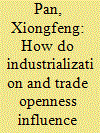

|
|
|
|
|
| Summary/Abstract |
Nowadays, multifaceted interdependence between macroeconomic variables results in an extended list of factors that have diverse impacts on energy intensity. Thus, sustaining energy intensity at a desired level demands advanced studies to investigate the multifarious influences of its factors and ensure proactive measures to deal with them. This paper aims to set up a path model to analyze the direct and indirect impacts of industrialization and trade openness on energy intensity in Bangladesh. The results corroborate that industrialization has a direct positive influence on energy intensity where trade openness shows a direct negative effect on it; and both industrialization and trade openness have negative indirect impact on energy intensity through technological innovation and economic growth respectively. In case of individual total impacts, only industrialization affects energy intensity positively, where trade openness, technological innovation and economic growth negatively do. Based on the empirical results, some policy implications regarding energy intensity and effects of its factors on it are also presented.
|
|
|
|
|
|
|
|
|
|
|
|
|
|
|
|
| 6 |
ID:
153057
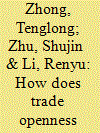

|
|
|
|
|
| Summary/Abstract |
This paper investigates the effect of trade openness and other variables on the demographic transition in China using the instrumental variables regression method based on provincial panel data for the period between 1981 and 2013. The results indicate that trade openness is one of the determinants of China's demographic transition and has two distinct effects: (i) an income effect that accelerated the demographic transition by increasing per capita income; and (ii) a human capital effect that suppressed the demographic transition by reducing human capital accumulation. The effects of trade on demographic transition vary across different regions. This study identifies the important determinants of demographic transition in China's regions, and has rich policy implications for demographic transition and the upgrading of trade structure.
|
|
|
|
|
|
|
|
|
|
|
|
|
|
|
|
| 7 |
ID:
168504
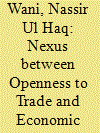

|
|
|
|
|
| Summary/Abstract |
The notion that the international trade is the foundation of economic growth dates long back, and even now, an irresistible body of literature confirms a strong and positive link between trade openness and economic growth. However, most of these studies are focused on developed countries. Indeed literature from developing countries are scant, those from under developed and a landlocked country like Afghanistan are almost non-existent. This article endeavours to innovatively scrutinize the relationship between trade liberalization and economic growth in Afghanistan, using biannual data for the period 1995–2016 and thus evaluates the comparative effect of three different measures of trade openness on the economic growth by using more rigorous econometric techniques. Autoregressive distributed lag (ARDL) method, JJ CO-integration and ordinary least square (OLS) results suggest significant positive long-run relationship between export and economic growth. In contrast, total volume of trade and imports have significant negative effect on the economic growth. The addition of variables and results of fully modified OLS suggest that the results are robust. The Granger causality and variance decomposition analysis indicate the unidirectional causality between trade openness and economic growth. In export model, causality runs from export to growth. Whereas, in the model with total volume of trade and import, causality runs from growth to total volume of trade and imports in Afghanistan. From the findings, it is concluded that the policymakers should focus on export promotion strategy to enhance the economic growth in Afghanistan. Besides, efficient utilization of capital goods should be ensured and reliance on non-capital goods should be less in order to ensure high domestic production in the country.
|
|
|
|
|
|
|
|
|
|
|
|
|
|
|
|
| 8 |
ID:
165525
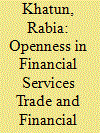

|
|
|
|
|
| Summary/Abstract |
This article investigates the long-run relationship between openness in financial services trade (OPTIFS) and financial development in five BRICS (Brazil, Russia, India, China and South Africa) economies, for the period of 1990–2012. It is found that the variables under consideration possess a long-run relationship in the mentioned economies. Fully modified ordinary least square (FMOLS) and dynamic ordinary least square (DOLS) have been performed to find the long-run coefficient of the variables. Results from FMOLS and DOLS have confirmed that OPTIFS has a positive and significant impact on financial development. The study reveals that 1 per cent increase in trade in financial services causes 0.109 increase in total credit to private sector, which is used as a proxy for financial development, indicating that the government should try to remove barriers from trade in financial services in order to develop better financial structure, thereby promoting further growth. It is also found that some of the control variables like gross savings and gross domestic product have positive and significant impact on financial development at 5 per cent level of significance
|
|
|
|
|
|
|
|
|
|
|
|
|
|
|
|
| 9 |
ID:
117528
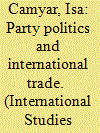

|
|
|
|
|
| Publication |
2012.
|
| Summary/Abstract |
How does party politics influence trade outcomes? Previous studies offer a limited understanding of the role of political parties in trade policymaking due to their restrictive assumptions that downplay the distinct organizational identity of political parties and the competitive logic of their interactions. This paper develops a theoretical argument that emphasizes the competitive forces of party politics as a key determinant of party preference for trade and hence of trade outcomes. This theoretical argument is illustrated and tested in analysis of the trade implications of strategic interactions between mainstream parties and niche parties. The empirical analyses confirm that party strategic factors need to be assigned a substantial analytical weight in explaining trade outcomes.
|
|
|
|
|
|
|
|
|
|
|
|
|
|
|
|
| 10 |
ID:
168502
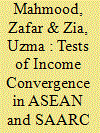

|
|
|
|
|
| Summary/Abstract |
The cherished goal of speedy economic growth in the Asian regional blocs cannot be achieved without attaining income convergence among them. Economic integration and assessment of income convergence or disparities among Asian blocs is the aim of this study. This study assesses a number of factors, such as trade openness, foreign direct investment, intellectual property rights protection and governance, to see how open economies are integrating themselves while competing with each other. Findings reveal that the SAARC group has not shown intra-regional income convergence, while the ASEAN group provides sufficient evidence. Although simultaneously considering SAARC and ASEAN groups in the form of a panel, there is evidence of non-convergence between the two regional groups. An important policy implication of the study is that the ASEAN and SAARC blocs are in dire need for combined and collective policy framework at the regional level.
|
|
|
|
|
|
|
|
|
|
|
|
|
|
|
|
| 11 |
ID:
156459
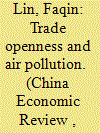

|
|
|
|
|
| Summary/Abstract |
We seek to contribute to the debate over trade openness and the environment by taking specific account of the endogeneity of trade openness. We use exogenous geographic determinants of trade as instrumental variables as well as distance to Huai River for identification which is based on China's heating policy. Using air quality measure from NASA, we find that trade increases three measures of air pollution: SO2, NO2, and Aerosol concentration.
|
|
|
|
|
|
|
|
|
|
|
|
|
|
|
|
| 12 |
ID:
150459
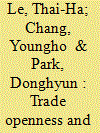

|
|
|
|
|
| Summary/Abstract |
We examine the relationship between trade openness and the environment in a cross-country panel, using the emission of particulate matter (PM10) as the basic indicator of environmental quality. The panel cointegration test results show a long-run relationship between particulate matter emissions, trade openness, and economic growth. We find that increased trade openness leads to environmental degradation for the global sample. However, the results differ according to the income of countries. Trade openness has a benign effect on the environment in high-income countries, but a harmful effect in middle- and low-income countries. These results are generally robust to different measures of trade openness and environmental quality. Interestingly and significantly, the results are consistent with the popular notion that rich countries dump their pollution on poor countries. Finally, we find evidence of a feedback effect between trade openness and particulate matter emissions for the global sample as well as different income groups of countries.
|
|
|
|
|
|
|
|
|
|
|
|
|
|
|
|
| 13 |
ID:
122453
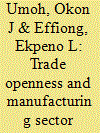

|
|
|
|
|
| Publication |
2013.
|
| Summary/Abstract |
How important is trade openness as a vehicle for driving productivity in developing countries? We offer a sector-specific analysis with focus on the manufacturing sector for meaningful policy insights. Using a modern econometric technique-the autoregressive distributed lag approach to cointegration-this article attempts to establish the relationship between openness to trade and manufacturing performance in Nigeria for the period 1970-2008. The results suggest that trade openness has a significant positive impact on manufacturing productivity in Nigeria both in the short and long run. These coefficient estimates are robust and stable over the time. Therefore, the policy direction for the manufacturing sector in Nigeria should focus more on open policies through trade liberalisation as a long-term plan. Reduction in trade restrictions and implementation of appropriate incentives are vital for resuscitating the performance of the sector. In this aspect, policy-makers should leverage the benefits of openness to the comparative advantages in the liberalised sector.
|
|
|
|
|
|
|
|
|
|
|
|
|
|
|
|
| 14 |
ID:
185897
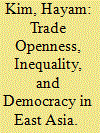

|
|
|
|
|
| Summary/Abstract |
Has trade openness made East Asian countries more or less democratic? Although numerous studies have explored the economic effects of market integration in the region, few have systematically examined the political consequences of trade liberalization. This research extends previous work by empirically investigating not only direct but also indirect links between trade globalization and democracy in East Asia. I find that the direct negative effect of trade integration on democracy is mitigated by its indirect positive impact via inequality. Empirical evidence is provided by the three-stage least squares method and pooled time-series data from 1975 to 2015 for 13 East Asian states.
|
|
|
|
|
|
|
|
|
|
|
|
|
|
|
|
| 15 |
ID:
146160
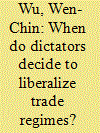

|
|
|
|
|
| Summary/Abstract |
This paper investigates how authoritarian leaders employ trade openness as a response to rising inequality. Based on the Heckscher–Ohlin model of international trade and models of democratic transition, I argue that unskilled laborers in authoritarian regimes can benefit from engaging in international trade, thus becoming more compliant to the authoritarian rules as their countries integrate into the world economy. Therefore, dictators in labor-abundant countries expand trade to neutralize democratization threats initiated by rising inequality. My argument uses supporting data from around eighty authoritarian regimes during the period from 1963 to 2003. I address endogeneity problems with dynamic panel data and instrumental variable regression models in this paper. My analyses suggest that economic globalization helps strengthen authoritarian regimes.
|
|
|
|
|
|
|
|
|
|
|
|
|
|
|
|
|
|
|
|
|